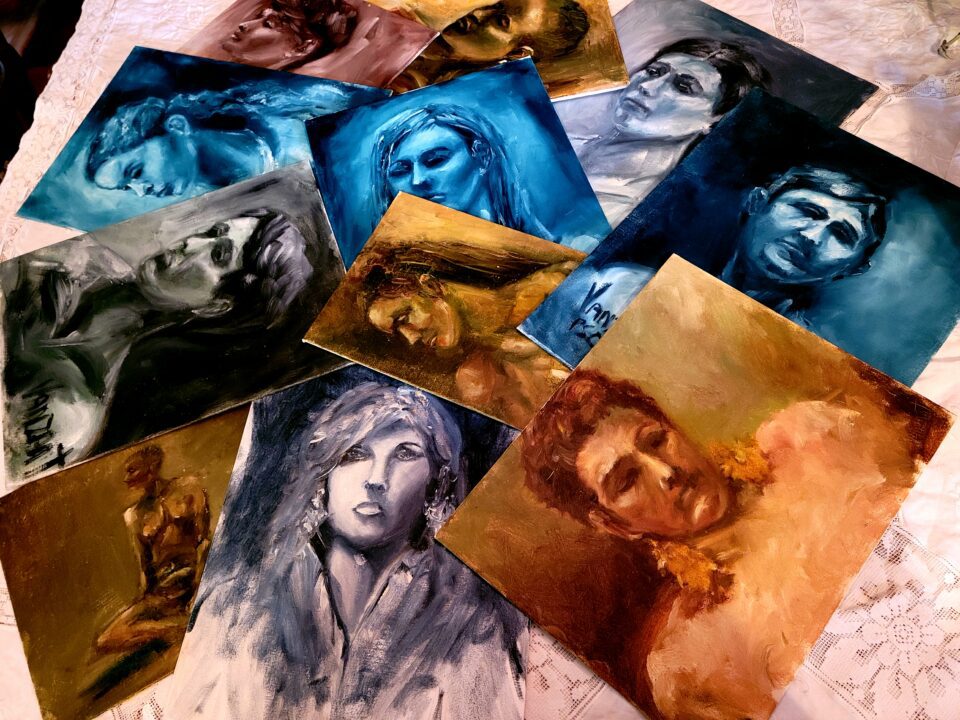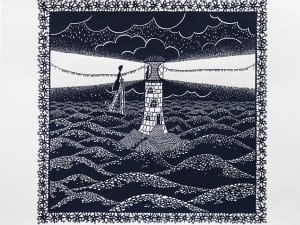Monica Vanzant was born in Hawaii and is based in New Jersey. A painter whose primary medium is oil, she explores how pattern and texture interrelate to help tell a story. Ideas spring forth through a variety of subject matter, including portraits, landscapes and still lifes. Vanzant has participated in numerous exhibitions throughout the USA.
A: In Issue 102 of Aesthetica, we display your latest painting, entitled Sunday. What is the background and meaning behind the piece?
MV: Sunday is one of three self-portraits created during the pandemic. I think this one was special to me because I decided to try a few new things. First, I decided to complete it one sitting and gave myself only five hours to do it. This was for no particular reason really – I just wanted every brush stroke to count.
Also, I decided to wear a brightly patterned dress, which is another thing I rarely do when painting self-portraits. And last, I included the background elements behind me. I remember it was a quiet Sunday and I was feeling happy and positive, so I decided to keep the name simple, hence the title. It is now one of my favourites I think, because it was kind of unexpected and I had no idea if I could pull it off.
A: What is it about your everyday experiences and striving to be a better person that have influenced the creation of Sunday?
MV: I’m not sure. I know that I do try to stretch my myself in all ways: not just in my creative process but also in the way I deal with challenges and how I interact with people. As I get older, I try to take things more in stride, which is maybe why I am trying to be a bit more spontaneous with my work, and let it tell me what it wants to be, and not worry so much about perfection every single time (at least perfection in my own head). I think that is why I limited myself on the time to complete Sunday; maybe I didn’t want to give myself any time to worry about anything except capturing the moment.
A: How different do you think Sunday would look if you had painted it before the pandemic?
MV: I know for a fact that I probably would have also taken a photo, started the painting on day one and finished it on another day, probably assuring it definitely would not have been titled Sunday.
A: How do you achieve texture and depth in your figurative works?
MV: Like most painters, I use brush strokes and different levels of thickness of my paint strokes. My approach depends on the concept of my painting. There are times when I first sketch in my composition using black and white acrylic as the underpainting. I usually do this if I want a more smooth and luminous texture but then there are times when I work alla prima with brushes and palettes knives, like I did on my paintings Hudson River Valley Pasture and my latest painting Love.
A: Do you think you’ll create more self-portraiture in the coming months?
MV: Absolutely. I complete a self-portrait every year. The painting Mulier was done last year during the first lockdown. I painted it after one of my favourite paintings by Rembrandt Peale currently hanging at the PAFA. Currently I seem to be the most convenient model available model so, yes, I will absolutely be painting more self-portraits.
A: You were born in Honolulu. How much has Hawaii influenced your landscape paintings?
MV: Not much at all unfortunately. I know Hawaii is a beautiful and exotic place, but we left when I was three, so I never experienced any of that. My father was the in the United States Air Force and was stationed in Hawaii when I was born. We lived there for three years and obviously I don’t remember anything about it. Strangely enough, I have travelled quite a bit but never back to Hawaii. Maybe one day I’ll make it back for a visit.
A: Tell me about The Artist’s Backyard – how was the creation experience different from working on other landscapes, such as the Wired series?
MV: It’s funny you should mention those because I painted both around the same time about four years ago. I created quite a few paintings of my surrounding area, realising that, even though I had travelled quite a bit, I’d rarely painted much of my hometown.
I don’t think there was any real reason why, except that maybe I had just been so busy that I didn’t take the time to fully appreciate my own environment, so I literally started with my own backyard and then branched out to the many beautiful parks and farms nearby which gave me plenty of material for landscapes like Landscape in Winter.
A: Where does the Wired series take place?
MV: The Wired series started with the view from my bedroom window of the telephone pole which I hated. There were years of wires dangling from it, yet I knew the ugliness was also the price to pay for the comfort of communication. I absolutely cannot wait until the US financially invests in underground wireless communication but until that happens, there will continue to be these tar-covered monstrosities on every street corner, so I decided to start the Wired series.
A: You’ve mentioned that one of your favourite stages of painting is the beginning – “the point that can be the start of something beautiful or could end in disaster”. Is it the unpredictable that excites you? How do you feel when the result is a disaster?
MV: No, I wouldn’t say that the unpredictability is exciting. As a matter of fact, it can be downright annoying and sometimes a bit terrifying, but I think it’s my favourite stage because it’s really the only point, or maybe the last point, when the art could still be whatever it wanted to be.
Once you start laying down line and pattern, sketches and colour, there comes the moment when you can’t really turn back – you can only go forward. After years of trial and error, I know now that I don’t paint disasters. I am not saying that every painting is a masterpiece – not by a long shot – but I am saying I know now that everything has a purpose and what I paint may not necessarily “good” but it has a purpose. It taught me something that I will use for the next painting and the next and the next…
A: What do you think is your strongest subject matter? Is your strongest subject matter the same as your favourite subject matter?
MV: Quite honestly, I am not sure how to answer this. I don’t really know what “strongest subject matter” means since I would think this would depend on how people respond to the art, yes? Maybe my quick portrait studies? At least I find them very interesting because they are simple and tonal.
I think I miss most of all my Saturday workshops at the Philadelphia Sketch Club. I am eternally at war with myself when we start because I tell myself I am going to do a full body study but then halfway through I usually pivot and start a new sketch of the face. And I mean I do this every single time!
I know now that it’s the light that comes in through the windows from about 10:00 until 12:00 and I always chase that light. I usually keep it simple, using one colour and white, documenting the light and shadow only, so that I don’t have to worry about colour. I have dozens of these little tonal studies, but I really love them.
As for my favourite subject matter, definitely landscapes. I feel so at peace when I am communicating the beauty of my surroundings.
A: You’ve noted that “If it were easy, everyone would do it”. What is it about your art practice that is challenging?
MV: Well, I believe that my art practice is challenging for the same reason that it is for any other artist. Trying to communicate our thoughts and ideas to an external source is challenging and no matter what the end result. Not everyone will always “get it” or find it successful. This road is not an easy endeavour for anyone.
In saying that, I do sometimes find that I have problems communicating my concepts in ways that are too literal which I think is a challenge for me as a self-taught artist. I came to this realisation when I realised that I’d spent years teaching myself how to paint “things” and that now it was time to start painting my ideas. It was an epiphany that I am forever grateful for, and I am still learning and growing creatively as an artist – doing things outside of my comfort zone.
A: What is a typical day like for you?
MV: I have another day job that I enjoy in the education industry, so that is my focus during the days – as I’m sure everyone understands that the bills must be paid – and then in the evenings and weekends, I paint. Usually, I paint on masonite board, which I prepare myself about once a month so that I’ll always have an available support when I need them, but I also use linen and stretch my own canvases in my home studio.
A: What does the rest of 2021 look like for your art practice?
MV: My goal is of course to continue to continue my journey of creating art that I love, and I would love to start travelling again, and maybe attend some workshops. I have always been an introvert, but I really do miss working around other artists in the creative hub of a workshop.
I truly believe that when you immerse yourself in a creative environment, your growth intensifies, and I miss this type of interaction. Also, I have been doing some writing again which is a bit terrifying, but I’ve got some things to say so I am throwing my hat in the ring and writing some short stories. Last, I am currently working on a line of fabric designs, so I am going to be very busy in the year 2022!
For obvious reasons, after this past year, I realised that there is no reason not to reach for what you want so that is exactly what I am going to do, and I truly hope everyone else will do the same.
monicavanzant.com
monicavanzant.blogspot.com
Images: all images are courtesy of the artist.
The work of Monica Vanzant appears in the Artists’ Directory in Issue 102 of Aesthetica. Click here to visit our online shop.









